Pale yellow dune moth (Copablepharon grandis) COSEWIC assessment and status report: chapter 5
Habitat
Habitat requirements
Copablepharon grandis occurs in sparsely vegetated sandy habitats. Sampling records from 2004–2005 supplemented with inferences about habitat conditions in previous sampling locations, suggest that the moth most often occurs in semi-stable dunes with sparse grass and forb cover. These include depressional blowouts, dune faces, and road cuts (see examples in Figure 4). It has also been recorded twice in sandy, eroded areas (at Maryfield, SK and Fort Qu’appelle, SK) that are not characterized as sand dunes. This association with loose sandy soils suggests that open sand is needed for egg laying or for larval development. Strickland (1920) also found that captive raised moths layed eggs in the soil. A larva purported to be of this species was also found in a “stubble field” at Monarch, AB (Strickland, 1920).
Figure 4. Habitat characteristics of sites where C. grandis was captured in 2004–2005:
- open blow-out near Artland, SK (1 C. grandis captured);
- semi-stable blowout near Dundurn, SK (12 C. grandis captured);
- human-made fireguard near Dundurn, SK (2 C. grandis captured);
- large south-facing semi-stable dune at Wainwright DND Base, AB (1 C. grandis captured);
- sand exposure along disturbed roadside in Sounding Lake, AB area (1 C. grandis captured); and
- suspected C. grandis habitat in the Bush Lake Sandhills near Table Mountain, SK (no sampling undertaken). All photos by N.A. Page.
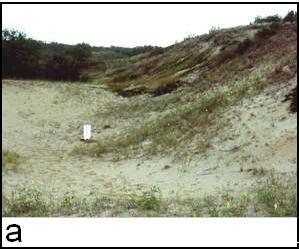
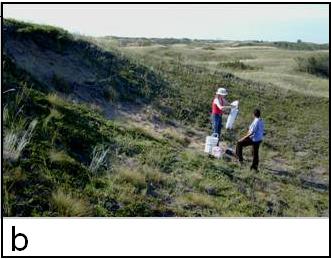
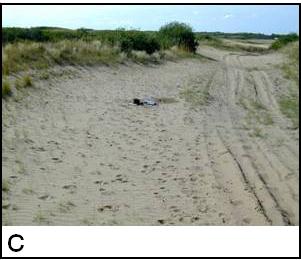
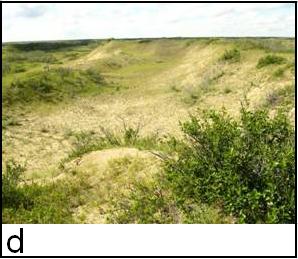
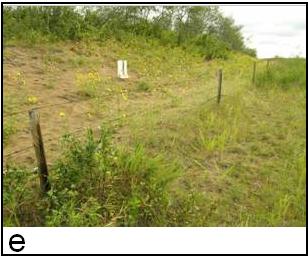
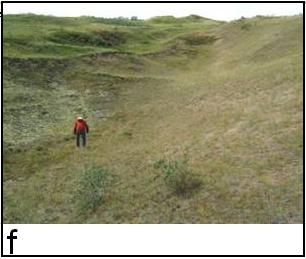
Open sand may not be the only critical environmental factor influencing the distribution of C. grandis. The moth was not captured in several sites in 2004–2005 in which habitat conditions appeared to be suitable. In particular, it has not been recorded in the Great Sand Hills, Burstall Sand Hills, or Seward Sand Hills--all sites with an assemblage of active, semi-stable, and stable sand dunes--nor was it captured in semi-stable dunes in Douglas Lake Provincial Park, SK. This information contributes to the difficulty in defining C. grandis’ specific habitat requirements and suggests that climatic factors may also be important.
Lafontaine (2004) noted that C. grandis is likely the most frequently collected species of Copablepharon because of its large geographic range and broader range of habitats. Fauske (1992) stated that it was associated with midgrass and bunchgrass prairies, and areas of aeolian drift soils.
Copablepharon grandis does not appear to be limited to a single host-plant for adult nectaring, reproduction (e.g., ovipositing), or larval feeding. This conclusion is based on the variability of plant species recorded within the immediate vicinity of sampling sites in 2004–2005 as well as the moth’s suspected use of open sand, rather than leaves or flowers, for ovipositing. Strickland (1920) reared a C. grandis larva on two unrelated plants--alfalfa (Medicago sativa L.) and barley (Hordeum sp.), which also suggests that the larvae do not rely on a single host-plant. The use of a common grass and a common legume is noteworthy in that it indicates that many plants are likely suitable host plants for larval feeding.
Plants recorded at sampling sites in Saskatchewan and Alberta in which C. grandis was captured include: prairie sandreed (Calamovilfa longifolia (Hook.) Scribn.), creeping juniper (Juniperus horizontalis Moench), sand dropseed (Sporobolus cryptandrusPursh), needle and thread grass (Stipa comata Trin. & Rupr.), silverberry (Elaeagnus commutata Bernh. ex Rydb), Indian rice grass (Achnatherum hymenoides (Roemer & J.A. Schultes) Barworth), blue grama grass (Bouteloua gracilis (Willd. ex Kunth) Lag. ex Griffiths), wheat grass (Agropyron spp.), lance-leaved psoralea (Psoralea lanceolata Pursh), sun-loving sedge (Carex pensylvanica((Mackenzie) W.A. Weber)), hay sedge (Carex siccata Dewey), pasture sagewort (Artemisia frigida Wild), prairie Junegrass (Koeleria macrantha (Ledeb.) J.A. Schultes), choke cherry (Prunus virginiana L.), lichens (Cladina spp. and Cladonia spp.), prairie rose (Rosa arkansana Porter), common annual sunflower (Helianthus annuus L.), and Canada wildrye (Elymus canadensis L.).
Plant communities found in semi-stable, sparsely vegetated dunes in Saskatchewan, Alberta, and Manitoba vary regionally but are often similar in composition and structure. Coenen (2003) described and classified sand dune plant communities in the Wainwright Dunes Ecological Reserve in east central Alberta which are characteristic of C. grandis habitat in terms of species composition and physiognomy. Two sparsely vegetated plant communities on sandy soils were identified: 1) sand grass–sand dropseed–hay sedge herbaceous vegetation; and 2) creeping juniper/sand grass–sun-loving sedge dwarf shrubland.Copablepharon grandiswas captured in similar plant communities in the Wainwright, Sounding Lake, Chauvin, and Sufferin Lake localities in 2004–2005. As well, the site in which 12 were captured at a semi-stable dune blowout at Dundurn, SK in August 2004 is very similar in terms of plant composition and open sand cover to the creeping juniper/sand grass–sun-loving sedge dwarf shrubland (see Figure 4b). These communities develop on sloped, well-drained sandy soils with some sand movement; the former has approximately 60% open sand while the latter has around 30% (Coenen, 2003). The creeping juniper/sand grass–sun-loving sedge dwarf shrubland community is common on depressional blowouts (see Figure 4b).
Other plant communities described from semi-stable sand dunes include a sun-loving sedge–sand dropseed–Schweinitz’s flatsedge (Cyperus schweinitzii Torr.)–sand grass plant community from the Manito Sandhills near the Sufferin Lake locality in west central Saskatchewan (Thorpe and Godwin, 1993) and a sand dropseed–prairie sandreed–Indian rice grass plant community from the Pakowki Lake area in southern Alberta (Coenen and Bentz, 2003). Hulett et al. (1966) described vegetation in the Dundurn area south of Saskatoon, SK, but did not formally characterize plant communities.
Sand hills in the Canadian prairies are characterized by fine or moderately fine sand, moderately high pH (8.1–8.3), less than 0.5% organic matter, and small amounts of silt and clay (<8% in total weight) (Hulett et al., 1966). Water-holding capacity is very low. The soils are classified as regosols by the Canadian Soil Classification System.
Habitat trends
Sandy soils are widespread in the southern Canadian prairies and are composed of glaciofluvial, glaciolacustrine, and deltaic sediments from the last glaciation that have been reworked by wind action (David, 1977). However, most sandy habitats are stable, vegetated and lack open sand except in isolated blowouts, drier dune ridges, road cuts, and other disturbed sites (Figures 4 and 5). The suspected association of C. grandis with sparsely vegetated sandy habitats suggests that the incremental process of dune stabilization that has affected most dune systems in the Canadian prairies in the last 200 years has maintained habitat for this species at some sites. However, the process of vegetation development on dunes often leads to the development of a sandy grassland which may exclude C. grandis. For example, exposed sand in the blowout shown in Figure 4b will likely be lost as vegetation, such as creeping juniper and bryophytes, colonizes. Copablepharon grandis may be associated with a transitional habitat that occurs between active dunes and stable, sandy grasslands.
Figure 5. Example of an isolated and largely stabilized dune (see arrow) in Bushy Lake Sand Hills, SK (Table Mountain area). The surrounding landscape is developed for agriculture or vegetated with shrub thickets, forest, or dry grasslands. Sampling was not undertaken at this site. Photo by N.A. Page.
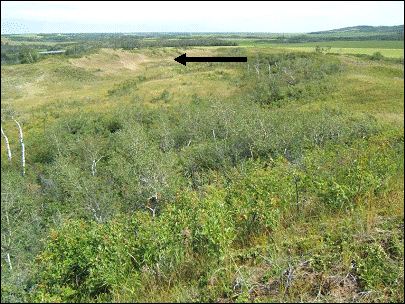
Several factors affect habitats in which C. grandis has been found: 1) sand dune stabilization; 2) reduced fire frequency; 3) cattle grazing; 4) land development and 5) recreational disturbance.
Stabilization of active sand dunes in the southern prairies in the past 100 years has been documented by considerable research (Wolfe et al., 2001; Wolfe and Thorpe, 2005; Hugenholtz and Wolfe, 2005). However, research has focused on active dune systems such as the Great Sand Hills, Burstall Dunes and Spirit Dunes, and there is very little specific information on changes in the extent or condition of semi-stable dunes in which C. grandis has been found. Vegetation colonizes dune surfaces during periods of increased precipitation, while prolonged drought results in reduced vegetation cover and an increase in dune activity (Wolfe et al., 2001).
Reduced fire frequency may affect sparsely vegetated sandy habitats in the southern Canadian prairies by increasing vegetation cover. Fires of both natural and anthropogenic origins were likely more common in the Canadian prairies in the past (Boyd, 2002), but the effects of these fires on dunes and dry grasslands is poorly understood.
Cattle grazing occurred in most of the sparsely vegetated sandy habitats visited in Saskatchewan and Alberta as part of the 2004–2005 sampling program. Minor grazing may maintain sparsely-vegetated conditions, but intensive grazing is likely detrimental to C. grandis because trampling disturbs vegetation, compacts soil (Figure 6), and may crush eggs, larvae, or pupae. Copablepharon grandis was not captured in any habitats with intensive cattle activity, but there was minor grazing activity in three of the sites in which it was captured.
Figure 6. Example of a small dune blowout (Duchess, AB) that has been disturbed by cattle grazing. Note the hummocked surface and trail formation from cattle use. Cattle often use dune blowouts for loafing. It is not known if C. grandis occurs at this site. Photo by N.A. Page.
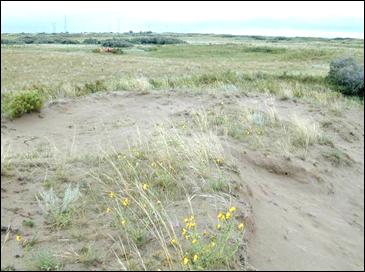
Land development including roads, buildings, water reservoirs, gas wells, and transmission lines may affect C. grandis habitat by destroying vegetation and disturbing soil.
Recreation may cause small-scale disturbance to C. grandis habitat. Minor recreational disturbance may help maintain exposed substrates, but more intensive disturbance, such as motorized vehicle use, may destroy vegetation, compact soils, or crush eggs, larvae, or pupae. Military training at CFB Wainwright and other DND sites, while not recreational, likely has similar effects as off-road vehicle use, including soil and vegetation disturbance. More active training, including the use of explosives, removes vegetation cover, exposes sandy soils, and may destroy moths and may also initiate fires.
Protection and ownership
Most Canadian sites with known or suspected C. grandis populations occur in publicly owned lands, primarily provincial lands that are leased for cattle grazing. Ownership and protection status of these sites is summarized in Table 1. Only one known population of C. grandis occurs primarily in a protected area: Spruce Woods Provincial Park (MB). A small portion of the population in the Suffern Lake area is within SuffernLake Regional Park; however, park activities focus on recreation rather than conservation. In addition, the species likely occurs in the Wainwright Dunes Ecological Reserve but it has not been captured there. The ownership of US sites is not known.
| Population/Locality | Province | Land Ownership and Protection Status |
|---|---|---|
| Wainwright | Alberta | Department of National Defence (CFB Wainwright); Wainwright Dunes Ecological Reserve likely also supports the species |
| Sounding Lake Sand Hills | Alberta | Unknown; provincial grazing land and roadsides |
| Calgary (unknown site) | Alberta | Unknown capture site |
| Chauvin / Siegner Lake Sand Hills | Alberta | Unknown; provincial grazing land? |
| Suffern Lake Regional Park | Saskatchewan | Portion of population in regional park; other areas in provincial grazing lands |
| Dundurn | Saskatchewan | DND base (active training); portion may also be in the White Cap Indian Reserve 94 and provincial grazing land |
| Caron | Saskatchewan | Unknown capture site |
| Maryfield (Pipestone Valley) | Saskatchewan | Private land |
| Fort Qu’appelle, Qu’appelle Valley | Saskatchewan | Private land |
| Spirit Dunes / Aweme | Manitoba | Spruce Woods Provincial Park; Department of National Defence (CFB Shilo) |